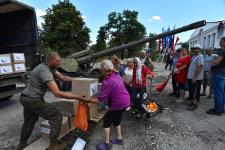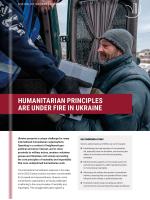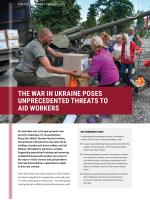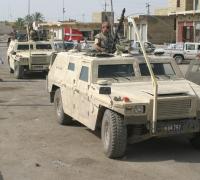The war in Ukraine poses unprecedented threats to aid workers

In addressing the emergent security challenges in Ukraine, NGOs, donors and policymakers could:
- Support specialised training programs tailored to the realities of the Ukrainian conflict addressing both kinetic and cyber threats.
- Develop strategies to protect humanitarian workers from electronic warfare, communication jamming and disinformation, including collaborations with international organisations and tech companies to develop verification tools for information shared online.
- Reduce bureaucratic demands and focus on SOPs that emphasise rapid response and practical in-country measures over protracted scenario planning.
Since the Russian full-scale invasion in 2022, Ukraine has faced a significant humanitarian crisis, with over 17 million individuals in need of aid. The international community has mobilized substantial resources, with Denmark providing approximately €4.3bn and €408mn in military and civilian aid respectively. However, insights from recent fieldwork in Ukraine reveal how new security threats are impacting the ability to deliver aid effectively and safely, and preventing emergency aid from reaching those most in need.
This brief highlights the risks to international aid organisations posed by modern interstate war, recommending a more flexible approach to humanitarian security and funding for more specialised training programs.
Frontline threats
From January to October 2023, there were 184 reported incidents disrupting humanitarian work, averaging one incident nearly every two days. Close to the frontlines, humanitarians work in unusually close proximity to military, humanitarian infrastructure and personnel, and have at times been misidentified as military assets or been deliberately targeted. In 2023, at least fifteen humanitarian workers were killed and thirty five injured, mostly due to collateral damage and Russian targeting of aid distribution points and warehouses. Due to these risks, some international organisations no longer operate in areas with the most urgent needs. In many cases, it is local-national partners who work in these high-risk areas. Another relatively new aspect for many professional aid workers is the presence of a high number of amateur volunteer groups, who often face the greatest risks but receive the least support.
Humanitarians have been impacted by cruise missiles, heavy shelling, and, increasingly, by FPV ‘kamikaze’ drones. This is a new experience for many humanitarian professionals who cut their teeth in places like Somalia, DRC and South Sudan. While some organisations may have experienced aerial bombardment in Syria and Afghanistan, the scale of the situation in Ukraine is a challenge. Since the early 2000s, humanitarian security systems have developed principally in response to the threat of transnational terrorism, or protracted civil war contexts. In the humanitarian imaginary, the threat of terror attacks, kidnappings, or sudden political instability loom largest, with sophisticated systems developed to track complex and shifting armed groups. Ukraine’s situation is markedly different. Here, a clearly demarcated 960km battlefront separates two modern state militaries, in a territory with a relatively strong central and local government, and that is easily accessible for citizens elsewhere in Europe.
Electronic warfare
Another challenge has been the impact of electronic warfare. Ukraine is the most connected war in history. Electronic warfare and communication jamming affect not only soldiers but also other actors operating near the frontline. There have been episodes where foreign war volunteers and humanitarians have apparently been geolocated and targeted on the basis of their smartphone use. These vulnerabilities are increasingly prioritised by both military and civilian authorities, and the seizure of smartphones and extraction of their data at checkpoints have become routine security concerns for humanitarian workers. This is particularly troubling when staff working across confrontation lines face scrutiny and danger from military authorities due to their online activities. In response to these threats, organisations have adopted specific technology protocols, such as the use of Ukrainian SIM cards and burner phones, and have implemented training on digital security and the management of social media activity.
Heavy shelling, missile and drone strikes along the eastern and southern frontlines are a new experience for many humanitarian professionals who cut their teeth in places like Syria, Somalia, Afghanistan, DRC and South Sudan.
This data-saturated environment presents a paradox. It can be a useful source of information, with staff subscribed to tens or even hundreds of Telegram channels providing regular real-time updates from the frontlines. However, these platforms are also arenas for narrative warfare and disinformation, complicating the discernment of reliable information for humanitarian operations. This is compounded by an (understandable) tendency among humanitarian actors to favour pro-Ukrainian media, potentially leading to an over-reliance on one-sided digital news sources. In reaction to this, some security professionals have adopted more cautious approaches to information sharing, delaying the dissemination of information in order to verify its accuracy.
The polarised media environment can also threaten the neutrality and impartiality of aid organisations.
For example, the International Committee of the Red Cross (ICRC) has become a target of Russian disinformation campaigns designed to undermine trust. More worryingly still, several respondents linked a dependency on remote tools and digital channels to an increase in the securitization and “bunkerisation” of humanitarian work, revealing a complex interplay between technology, security, and humanitarian practices that deserves further investigation.
Because the digital domain is now a central part of war, its significance for the safety and security of humanitarian workers is likely to increase. Whilst the impact of increased digital connectivity is currently being debated in international humanitarian law, on the ground it is having significant implications for humanitarian delivery, especially emergency relief, which requires quick response to events based on accurate and verifiable information. It also makes humanitarian staff more exposed and vulnerable, in terms of being targeted in the field through geolocation.
Bureaucratic burdens
At times, overly rigid standardised security procedures have hampered the capacity of some organisations to adapt to these new dynamics, highlighting the need for more flexible and adaptable security protocols.
As is the case in other conflict zones, security measures vary significantly among NGOs, with some adopting stringent protocols and others a more relaxed security posture. This difference in approach is particularly evident amongst amateur volunteer groups, who may be more willing to accept elevated risks. However, Russia’s largely unprecedented full-scale invasion of Ukraine immediately rendered many pre-existing safety protocols inadequate. INGOs that were operational in Ukraine prior to the 2022 invasion had to overhaul established SOPs and contingency plans, whilst those new to Ukraine developed them from scratch.
This meant that at the immediate onset of the war, many organisations were diverting scarce resources and energy towards developing rigid standard operating procedures (SOPs), many of which have proven to be ineffective in addressing the unprecedented and rapidly changing security situation. These documents are often viewed as a consequence of stringent insurance requirements, and function as box-ticking exercises for headquarters rather than practical tools for workers in the field. Moreover, it is highly improbable that security plans encompassing all SOPs for every eventuality, which can extend beyond 100 pages, will be thoroughly examined by staff.
This experience has shown the importance of prioritizing immediate operational safety and rapid response capabilities rather than extensive scenario planning. Standardization and procedure are not always helpful and, as was the case in early 2022, may even hinder timely and effective response, diverting resources during an unprecedented crisis. While some standardization is necessary for consistency and quality, there should be a balance between standardization and flexibility, allowing organisations to adapt their procedures to the specific needs of the situation and context.
Several respondents linked a dependency on remote tools and digital channels to an increase in the securitization and ”bunkerisation” of humanitarian work, revealing a complex interplay between technology, security, and humanitarian practices.
To support this, donors can prioritize outcomes rather than processes, and trust humanitarian organisations to make the best decisions regarding resource allocation. Enhancing the capacity of NGO security networks is another way to reduce the bureaucratic burden while tailoring security to the operational context. These networks are crucial for organisations with limited security infrastructure, as they rely on informal networks and collective resources. In particular, there is a need for greater coordination and information sharing with local NGOs.
Specialised training in demand
Many existing training models are not suitable for responding to large-scale interstate war, or the impact of electronic warfare, underscoring the need to develop new specialised training models to keep humanitarian staff safe and ensure effective and timely delivery of emergency aid.
In this context, the relevance and cost-effectiveness of established programs like Hostile Environment Awareness Training (HEAT) and Hostile Environment Integrated Security Training (HEIST) have been subject to debate. There can be significant disparities in the quality, content and effectiveness of these training programs. Particularly early on, many training courses were designed for contexts like Syria or Somalia where terror attacks and kidnapping are the key threats, and do not address the frontline risks faced in Ukraine. Moreover, there is concern over the rationale of mandating such training for staff who are not on the frontlines, with some suggesting that it is more a requirement of due diligence or insurance than of practical necessity, and therefore constitutes an inefficient use of funds. Many courses are unavailable to local-national NGOs, especially if they are held outside of Ukraine (due to martial law) or not given in the Ukrainian language.
One recent indication that this need is being recognised is the opening of the first Humanitarian Training Centre (HTC) in Ukraine intended to deliver specialized safety training in November 2023 by the International NGO Safety Organisation (INSO). INSO training is free for all eligible LNGOs and INGOs, and scaling up should be a priority.
DIIS Experts




